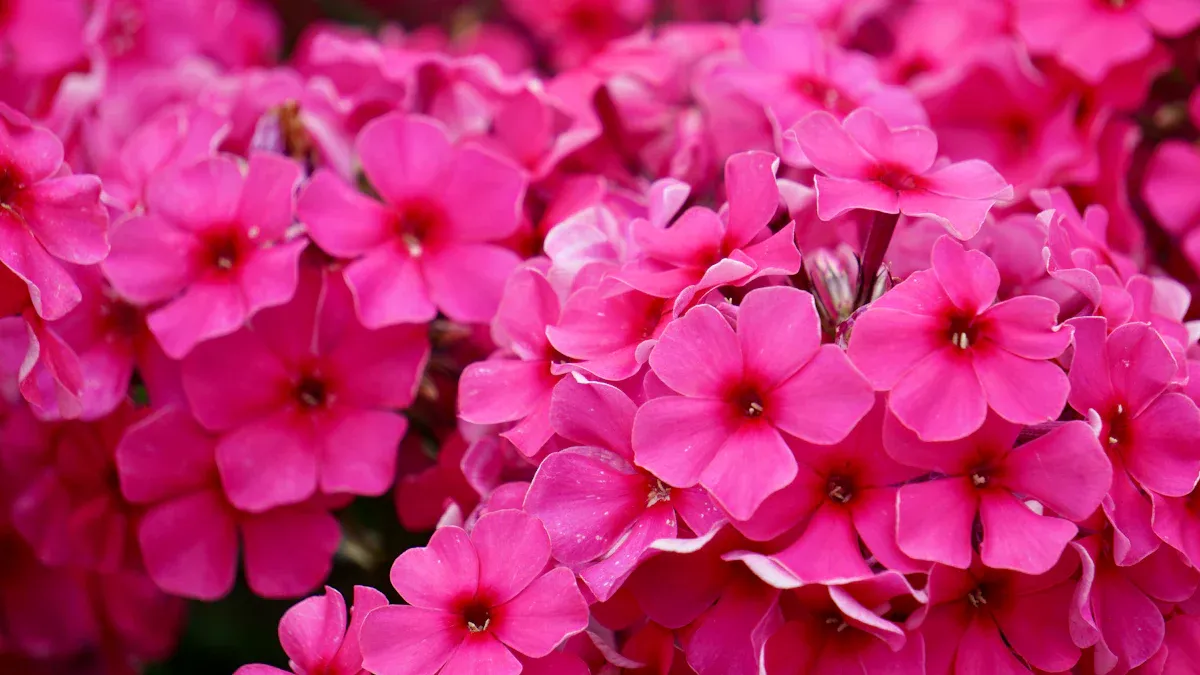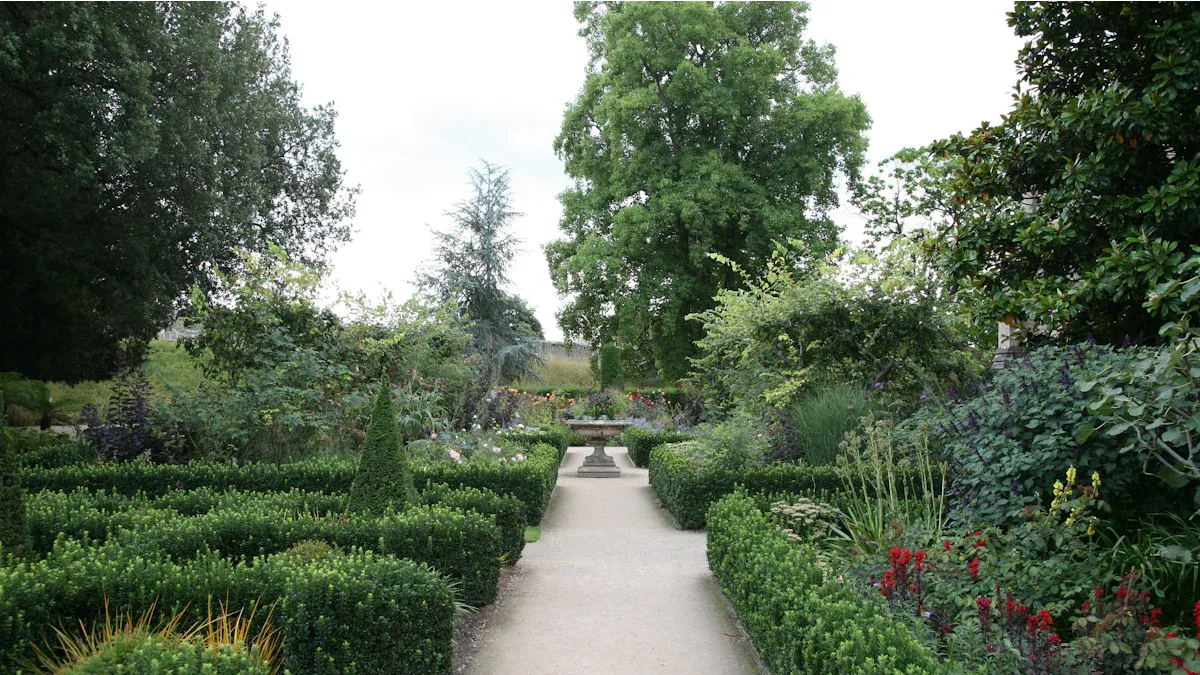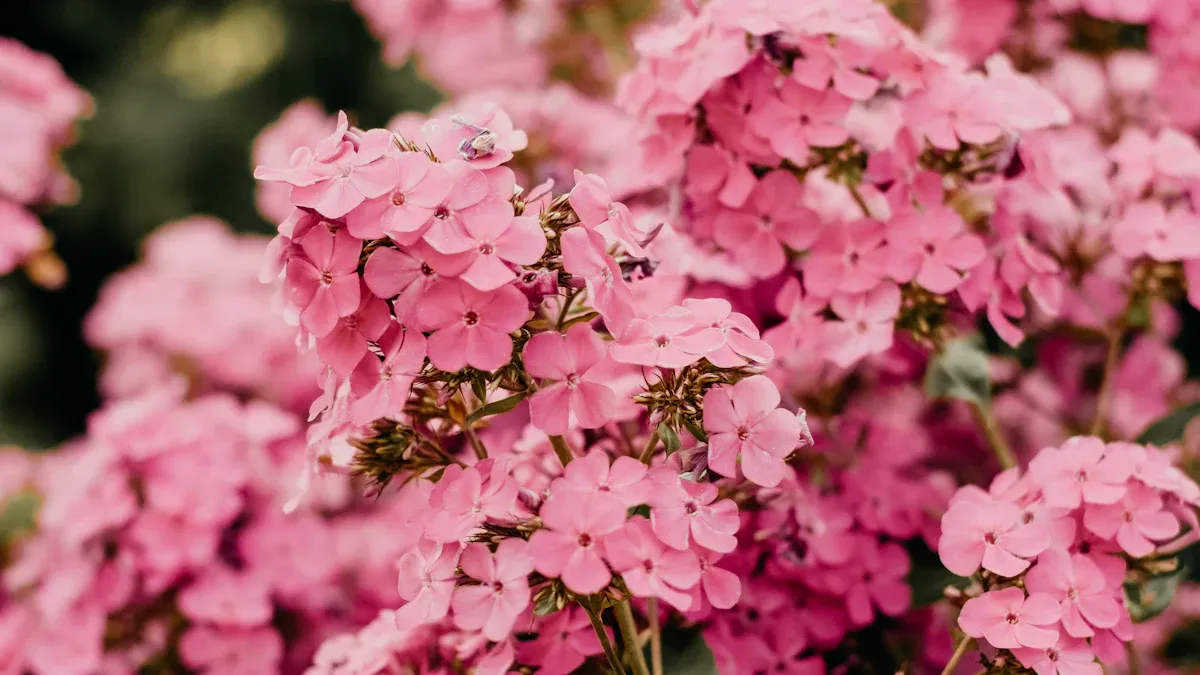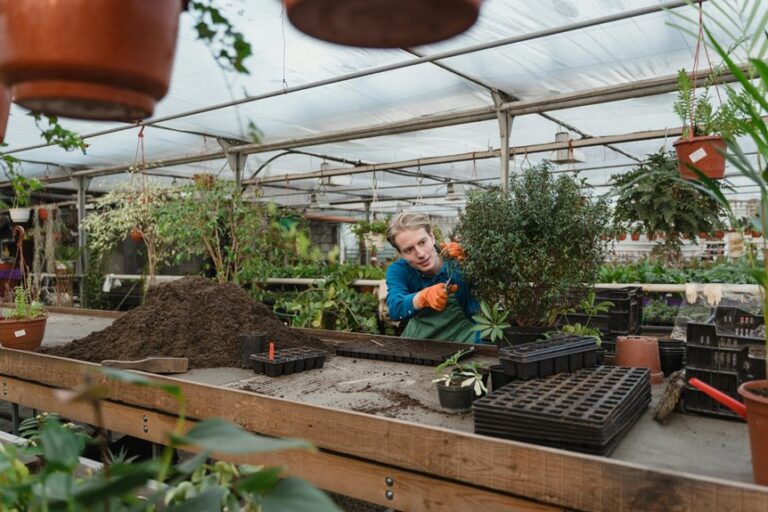
Planting phlox can bring vibrant colors to your garden, but spacing is key to their success! When you plan your garden, think about how much space to leave between each plant. Proper spacing not only helps your phlox thrive but also makes your garden look its best. Ready to dive into the details? Let’s get started!
Key Takeaways
Space Garden Phlox about 12 to 18 inches apart to promote healthy growth and prevent competition for resources.
Creeping Phlox should be planted 15 to 18 inches apart, or up to 2 feet in humid areas, to ensure good air circulation.
Proper spacing helps prevent diseases like powdery mildew by allowing for better airflow around the plants.
Water phlox deeply but infrequently, and prune regularly to maintain plant health and appearance.
Choose a sunny location with well-draining soil to maximize the growth and beauty of your phlox garden.
Spacing Factors

Garden Phlox
When planting Garden Phlox, you should aim for a spacing of 12 to 18 inches between each plant. This distance allows each phlox to grow without competing for resources. If you crowd them too closely, they may struggle to thrive.
Tip: Proper spacing is crucial for air circulation. Good airflow helps prevent diseases like powdery mildew, which can be a real problem in humid conditions. When plants are too close together, they trap moisture, creating a perfect environment for mildew to flourish.
Research shows that maintaining adequate space not only promotes healthy growth but also enhances pollination. Higher densities can attract more pollinators, which is beneficial for the overall health of your garden.
Creeping Phlox
For Creeping Phlox, you should plant them about 15 to 18 inches apart, especially if you’re aiming for a mass planting effect. This spacing allows the plants to spread out while still creating a lush ground cover.
Note: Proper spacing is essential for thriving plants. When you give Creeping Phlox enough room, you help ensure they receive adequate sunlight and air circulation. This is particularly important for preventing mildew, which can hinder their growth and overall health.
In regions with high humidity, consider increasing the spacing to about 2 feet apart. This adjustment helps maintain airflow and reduces the risk of disease. Remember, healthy plants lead to a vibrant garden!
Factors Influencing Spacing
Several factors influence how much space to leave between your phlox plants:
Plant Variety: Different species have varying growth habits. For instance, Garden Phlox typically requires more space than Creeping Phlox.
Environmental Conditions:
Soil drainage affects how much space is needed to prevent root rot.
Air circulation is crucial to reduce the risk of mildew.
Moisture levels influence plant health and spacing requirements.
By considering these factors, you can make informed decisions about the space to leave between your phlox plants, ensuring they flourish in your garden.
Planting Tips

Correct Space to Leave
Maintaining the recommended spacing between your phlox plants is crucial for their health and growth. When you plant them too close together, they compete for nutrients, water, and sunlight. This competition can lead to stunted growth and increased susceptibility to diseases.
To help you visualize the ideal spacing, here’s a quick reference table:
Type of Phlox | Recommended Spacing |
|---|---|
Garden Phlox | 18 inches apart |
Creeping Phlox | 2 feet apart |
Tip: Always aim for at least 12 to 18 inches between Garden Phlox and 15 to 18 inches for Creeping Phlox. This spacing promotes good air circulation, which is essential for preventing issues like powdery mildew.
Timing is also key when it comes to planting phlox. Here are some guidelines to ensure optimal growth:
Plant phlox in spring or fall to maximize growth and survival rates.
If you choose fall, make sure to plant a few weeks before the first frost.
In spring, wait until the soil is free from melted snow and ice before planting.
Proper timing allows your phlox to establish their root systems before facing environmental stresses like heat or frost. Remember, planting at the right time with the correct spacing will help your phlox thrive!
Tools and Materials Needed
Before you start planting, gather the following tools and materials:
Tools and Materials |
|---|
Hand trowel |
Gardening gloves |
The perfect location/container |
Water source |
With these tools in hand, you’re ready to create a beautiful phlox garden.
Note: When planting, ensure you give spreading varieties enough room to trail on the ground or over the edge. This will enhance their natural beauty and keep your garden looking tidy.
By following these planting tips, you’ll set your phlox up for success. Happy planting!
Maintenance Considerations
Maintaining your phlox plants is essential for their health and longevity. Proper spacing plays a significant role in how you care for them. When you space your plants correctly, you improve air circulation, which helps with watering and pest control.
Watering and Pruning
With adequate spacing, you can water your phlox more effectively. Plants that are too close together may not receive enough moisture, leading to stress. Make sure to water deeply but infrequently. This encourages strong root growth.
Pruning is another important aspect of maintenance. When you prune, aim to remove dead or diseased stems. This practice not only keeps your plants looking tidy but also promotes better airflow. Remember, good airflow helps prevent issues like powdery mildew, especially if you don’t use mildew-resistant varieties.
Pest Control
Spacing also helps in controlling pests. Here are some common pests that affect phlox:
Mites
Phlox plant bugs
Thrips
Leafhoppers
Aphids
Proper spacing reduces stress on your plants, making them less attractive to these pests. Healthy plants are more resilient, so maintaining good health through adequate watering, weeding, and pruning is essential.
Tip: Proper plant spacing is crucial for preventing powdery mildew. It allows for better air circulation, which is essential in controlling pests like spider mites.
Lifespan of Phlox
When you follow expert guidelines for spacing and care, your phlox can thrive for several years. For example, Phlox ‘White Pepper’ has an average lifespan of 3-5 years when properly cared for.
To keep your phlox healthy, consider these maintenance tips:
Maintenance Task | Frequency |
|---|---|
Watering | Weekly (deeply) |
Weeding | As needed |
Pruning | Early spring |
By following these maintenance considerations, you’ll ensure your phlox plants remain vibrant and healthy throughout their growing season. Happy gardening!
In summary, spacing your phlox plants correctly is vital for their health and beauty. Here are some key takeaways to remember:
Garden phlox should be spaced about 18 inches apart.
Creeping phlox needs around 2 feet of space.
Larger varieties require even more room, about 24-30 inches apart.
By providing adequate spacing, you ensure good air circulation, which helps prevent mildew and supports healthy growth. 🌼
Don’t forget to choose a sunny spot with well-draining soil and keep your plants well-watered. With these tips, you’ll enjoy a vibrant and thriving phlox garden for years to come! Happy gardening!
FAQ
What type of soil is best for phlox plants?
You should use well-draining soil rich in organic matter. Phlox thrives in loamy or sandy soils that retain moisture without becoming waterlogged.
How often should I water my phlox?
Water your phlox deeply once a week. During hot, dry spells, you may need to increase watering to keep the soil consistently moist.
Can I grow phlox in partial shade?
Yes, phlox can tolerate partial shade, but they prefer full sun. Aim for at least 6 hours of sunlight daily for optimal growth and blooming.
When should I fertilize my phlox plants?
Fertilize your phlox in early spring with a balanced fertilizer. This helps promote healthy growth and vibrant blooms throughout the growing season.
How do I prevent pests on my phlox?
To prevent pests, maintain proper spacing for airflow and regularly inspect your plants. You can also use insecticidal soap or neem oil if needed.


